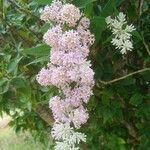Shrub or tree, up to 5 m. tall, with reddish-brown bark; young parts tomentellous, glabrescent.. Leaves shortly petiolate; petiole about 3 mm. long; lamina lanceolate or narrowly lanceolate, up to 10 cm. long, 2.5 cm. wide, shortly attenuate to an acute apex, rounded or cordate at the base, crenulate.. Inflorescence a compound raceme of dense clusters of cymules; lateral racemes up to 6 cm. long and 2.5 cm. in diameter; pedicels obscure.. Corolla lilac to mauve or violet, with darker or orange centres; corolla-lobes very broadly oblong, with rounded apex.. Anthers subsessile, inserted below the throat.. Ovary almost spherical, densely hirsute above.. Fig. 6/6, p. 37.
Shrub or tree, 1-5 m high, sometimes up to 8 m high. Leaves sessile or subsessile; blade narrowly ovate to narrowly linear-ovate, 30-145 x 7-42 mm, apex acuminate, base cordate or auriculate, margins finely, regularly crenate, upper surface dark green, rugose, lower surface rusty or white tomentulose, reticulate. Stipules distinct, leaf-like, apex broad, base auriculate. Flowers: in cymes, cymes large terminal, pyramidal bunches; stamens included; corolla 7-11 mm long, cream-coloured, lilac, lavender-blue, purple or white with deep orange throat; Jun.-Nov.
Tree or shrub, 1-8 m high; stems many, long, slender, lateral branches suberect, tomentulose (white or rusty). Stipules broadly rounded at apex, auriculate. Leaves opposite and decussate, sessile or subsessile, dark green, glabrescent, distinctly rugose above, rusty or white tomentulose, reticulate below; blade ovate-lanceolate to linear-lanceolate acuminate, base deeply cordate to auriculate. Inflorescences cymose, large terminal, pyramidal bunches, stellate-tomentose. Flowers cream-coloured or lilac with deep orange throat. Fruit small capsule.
A shrub or small tree. It is 3-8 m tall. There are often many stems from the base. The branches tend to droop. The bark is reddish brown. The small branches are covered with dense woolly hairs. The leaves are broadly sword shaped. They are 3-14 cm long by 0.7-4 cm wide. They are dark green or grey-green and wrinkled above. Underneath they have rusty of white hairs. The base is lobed. The flowers are white to cream or purple and 10 mm long. They are in heads 12 cm long. The fruit are oval and 4-5 mm long.
Corolla white or lilac to purple, with a deep orange throat, with erect lobes (2–)2·5–3·5 times as long as the calyx, 6–9 mm. long, outside tomentose, inside hirsute on the base of the lobes and within the tube, except for the glabrous base; tube nearly cylindrical, (1·4)2–2·7 times as long as the calyx, 2·5–3·2 times as long as the lobes, 4·2–6·8 mm. long, slightly widened towards the throat and there about 2 mm. wide; lobes suborbicular to oblong, 1·8–2·5 x 1·2–1·8 mm., rounded, entire, spreading.
Leaves opposite, sessile or shortly petiolate; petiole — if present — up to 7 mm. long; lamina narrowly ovate to narrowly oblong, (2–)4–6·5 times as long as wide, 4–17 x 0·8–4·5 cm., sometimes a little smaller, long–acuminate, with the apex acute, deeply cordate to auriculate at the base, crenate, bullate, finely and distinctly rugose and glabrescent above; venation conspicuous, reticulate.
Shrub or tree, 1-5 m high, sometimes up to 8 m high. Leaves subsessile, cordate to auricled at base, upper surface rugose. Interpetiolar leafy stipules present. Corolla tube long, cylindrical. Stamens included. Flowers cream, lilac, lavender-blue, purple or white with deep orange throat.
Willowy shrub or tree, up to 8 m tall. Leaves sessile, discolorous, lanceolate, margins crenate, base auriculate. Flowers in terminal, paniculate cymes, tubular with anthers included, white to purple with orange throat. Fruit an ellipsoid capsule.
Pistil 2·8–5 mm. long; ovary subglobose, laterally compressed, 1–1·2 x 1 x 0 8–1 mm., hirto–pubescent with stellate hairs, bilocular; style with stigma 2–3 mm. long, glabrescent; stigma large, clavate, often larger than the style.
Willowy shrub or tree to 8 m. Leaves sessile, discolorous, lanceolate, margins crenate, base auriculate. Flowers in terminal, paniculate cymes, tubular with anthers included, white to purple with orange throat.
Calyx campanulate, 2–3 mm. long; tube 1–3 times as long as the lobes; lobes subequal, broadly to rather narrowly triangular, 0·8–1·5 times as long as wide, 0·5–1·5 x 0·5–1 mm., acute, entire.
Branchlets white– or, (especially when dry) rusty–tomentose with stellate hairs as the leaves beneath, the peduncles, bracts beneath, and calyx and corolla outside.
Stamens included; filaments very short, inserted 3–4 mm. above the corolla base; anthers oblong, 0·8–1·5 x 0·3–0·5 mm., glabrous; cells parallel.
Inflorescence paniculate, very variable in size, 2–15 x 1–10 cm. (30 x 25 cm.); ultimate branches 3–flowered, more or less sessile and clustered.
Seed medium brown, obliquely tetrahedral, 0·8–1·5 x 0·4–0·6 x 0·3 mm. narrowly winged at the edges; both wings and testa minutely reticulate.
Capsule 3–4·5 x 2·4 x 1·4–2 mm., ellipsoid, exserted by about half from the calyx, apiculate, hairy as the ovary but less densely.
In each locule one axile circular peltate placenta with about 20 ovules outside.
Shrub or sometimes small tree, 1–8 m. high.
Flowers sessile, sweet–scented.
Stipules foliate.


